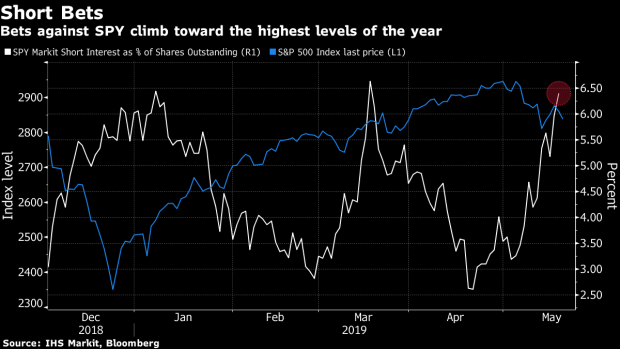May 20, 2019
Pain Is Proving More Durable in S&P 500 as Traders Lean on Shorts
, Bloomberg News

(Bloomberg) -- As rebounds get less robust, stock traders are taking precautions to shield themselves amid signs of a deepening impasse on trade.
U.S. equities failed to muster one of the rousing recoveries that have marked many May afternoons, with technology firms and the Nasdaq 100 bearing the brunt of the selling. Hedges are being deployed in case shares fall further, with short interest on the most popular S&P 500 exchange-traded fund surging toward the highest levels of the year.
“When the trade negotiations broke down, that was a big change” said Matt Maley, equity strategist at Miller Tabak + Co. “You have to adjust. When the market goes down in reaction to new news -- like we just got in the breakdown of the trade negotiations -- when the initial bounce fails, that’s when people stop buying the dips.”
Short interest as a percentage of shares outstanding on the SPDR S&P 500 ETF Trust, better known by its ticker SPY, has risen to 6.4%, according to data from IHS Markit Ltd. That’s not far off from this year’s highs seen in March, and more than at any time seen during the fourth-quarter rout.
The S&P 500 fell 0.7% Monday, while the tech-heavy Nasdaq 100 plunged 1.7% after software and chip companies affirmed they’re freezing the sale of components to Chinese telecommunications company Huawei Technologies Co. The Philadelphia Semiconductor Index dropped 4%, putting in on track toward the worst monthly loss since 2008.
For two weeks, while trade headlines occasionally led to quick swoons, investors have been largely immune to lasting losses. Overnight selling during Asian and European hours has often proved a weak signal, with U.S. traders bidding prices back up. While some estimates for trade fallout in the stock market are severe, the base case for many investors has been that a U.S.-China deal will be reached.
That hypothesis is coming into question. UBS Group AG now forecasts just a 20% chance of a breakthrough when President Donald Trump and his Chinese counterpart Xi Jinping meet next month at the G-20 summit. So as investors contend with the prospect of tweets and headlines jolting markets for months more, the impetus to lean too far in is waning.
“In a time of heightened uncertainty, now is not the time to be swinging for the fences with high-conviction bets,” Alexander Dryden, global strategist at JPMorgan Asset Management, said on Bloomberg Television. “U.S. and China trade fears will calm down in the shorter-run, but when we’re looking for the longer-run, investors who are going to be in the market for the next 15 or 20 years need to get their head around the fact that U.S. and China tension is going to be part and parcel of investing going forward.”
The U.S. has already raised duties on $200 billion of Chinese goods and has threatened that more could be on the way. China has retaliated as well, saying higher tariffs on U.S. imports will go into play June 1. The Trump administration’s latest moves against Huawei have also garnered harsh words from China, with the country warning against further moves.
For Ed Keon, a portfolio manager for QMA, a quantitative firm in Newark, New Jersey, handicapping what will happen and what it means for markets is a fool’s errand. He’s advising investors use prudence, and in the meantime has taken down the firm’s exposure to global equities.
“In this case, caution is called for,” Keon said. “Managing other peoples’ money is not just about maximizing expected return, it’s also about managing risks. And right now there’s more downside risk than there is upside potential.”
To contact the reporters on this story: Sarah Ponczek in New York at sponczek2@bloomberg.net;Vildana Hajric in New York at vhajric1@bloomberg.net
To contact the editors responsible for this story: Jeremy Herron at jherron8@bloomberg.net, Chris Nagi, Richard Richtmyer
©2019 Bloomberg L.P.





